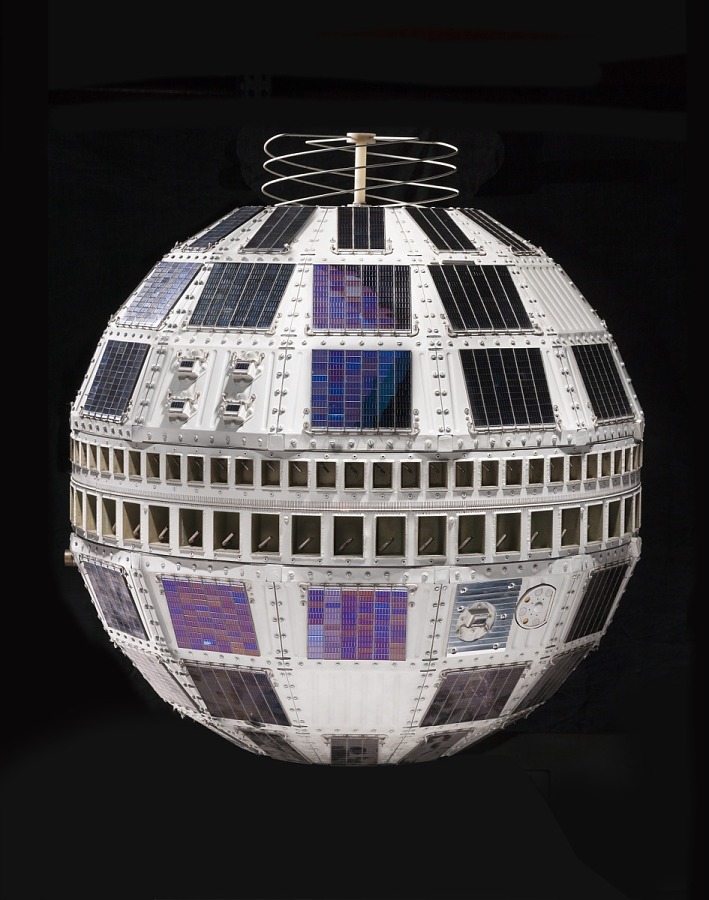
In the early days of the space age, there were few precedents for how things should be done. For example, would communications satellites be owned and operated by businesses or governments? The answer to that question in the East was simple; the government of the USSR owned and operated everything they launched into space. In the West, it was a little more complicated.
Corporations were eager to leverage space to advance their business communications requirements. Less expensive and greatly improved telephone, telegraph, and television transmissions between continents and nations was the overall goal. For example, communication satellites could make live TV broadcasts from another hemisphere possible, and reduce the time it took to transmit telegraph news stories and photos. In the United States, AT&T was particularly interested. Bell Telephone Laboratories (Bell Labs) was the research and development arm of AT&T, and designed a plan to make it happen.
Bell labs conceived of a system of multiple satellites in elliptical orbits. In the early 1960s rockets capable of putting a payload high above Earth in geosynchronous orbit, where comm satellites are located today, had yet to be developed. Low-Earth orbit, where Mercury astronauts were traveling, wasn’t high enough to be useful for communications between continents. Bell engineers had to design their satellites for something in between, and they decided on an elliptical orbit. During each pass around the Earth, the satellite would be at a low altitude on one side of the planet and reach an high altitude on the opposite side of the planet. It was during this high-altitude portion of the orbit that the comm satellite could provide communications between continents, and this portion of the orbit only lasted between 18 and 22 minutes out of a 2.5 hour complete orbit. In order to have continuous coverage then, multiple satellites were needed – at least eight. While multiple comm satellites were initially planned, only three were built: Telstar 1, Telstar 2, and a backup in case either of the first two were lost in a failed rocket launch. The backup is now part of the Smithsonian’s Air and Space Museum collection. All three were built in-house by Bell Labs.
The spacecraft was small, confined by the limitations of the rockets of the day. It measured about 34.5 inches (876.30 mm) in diameter, and only weighed about 170 pounds (77 kg). Telstar was designed as a sphere, with many small solar cells, the sum total of which only produced 14 watts of electricity. That is not much power to work with, consequently the satellite’s transmitter produced a very weak signal. In turn, the ground station receivers (satellite dish) had to be enormous to pick up Telstar’s signal: 177 feet (54 m) across and weighing in at 375 tons (340,000 kg).

Of course, AT&T would need partners overseas with which to communicate, a rocket launch service to put their communications satellites into orbit, and multiple ground stations on both sides of the Atlantic to route telephone, telegraph, and television communications through the satellites. The American telco giant formed a consortium with its organizational equivelants in the UK, France, Canada, Germany, and Italy. AT&T contracted with NASA for launch services. (NASA was the only choice at the time).
On July 10, 1962, NASA launched Telstar 1 on a Delta/Thor rocket from Cape Canaveral, Florida. Telstar was the first commercial satellite to carry a television broadcast feed, telephone calls, and telegraph images. Unfortunately, Telstar 1 passed through the Van Allen radiation belts repeatedly and by February, 1963, succumed completely to the damage caused to its circuits. Telstar 2 was launched on May 7, 1963. It too, eventually fell victim to radiation. Although non-operational, both vehicles are still in orbit today.
The Kennedy administration, meanwhile, decided that government would be better at owning and operating communication satellites and, through legislation, formed COMSAT and INTELSAT. Both are lengthy tales that require their own space and another time, perhaps.
The Telstar satellite communication program was a huge hit, capturing the public imagination. So too, was an instrumental by a British group called the Tornados. They recorded their tune, “Telstar” on July 22, 1962, and released it on August 17, 1962. It became the number one hit on the U.S. Billboard Hot 100 by December, 1962. It was only the second British tune to become a number one hit in America. “Stranger on the Shore” was first, in May 1962. “The Tornados – Telstar – New improved stereo remix” (3:27):
Question of the Night: What is your favorite tune about technology? (Loose interpretation… it could be “Car Wash”, for example).
